What Do Baby Chameleons Eat? [Full Guide]
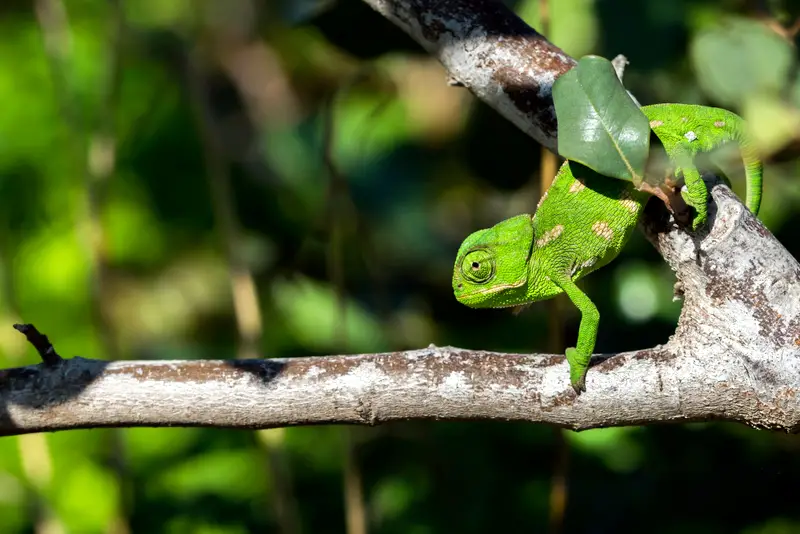
Chameleons are a fun reptile to have around. You can watch them climb and chase their food inside their enclosure. However, one of the most important parts of caring for a baby Chameleon is its diet. So, what do Chameleons eat? In this article, we answer that question and more.

For instance, we’ll give a brief overview of what a baby Chameleon is. Then, we’ll share a list of food for Chameleons, the best diet for them, what they cannot eat, and what they eat in the wild. Finally, we’ll provide tips and advice for how to feed your baby Chameleon, how often to feed them, and how much you should give them within one feeding.
Contents
Table of Contents
What Is A Baby Chameleon?
A baby Chameleon, upon hatching, is known as a hatchling. They are babies until they are six months of age and then are considered juveniles. When they turn a year old, they’re adults.
Baby Chameleons are born on the go, knowing that predators are after them. But, unfortunately, their mother has no maternal instincts. So, once she lays her eggs, that’s it. She no longer cares for her babies.
So, you can expect your Chameleon to be independent. Also, they’re generally shy and solitary creatures. They’re fun to have as pets, but if you’re looking for a pet to cuddle with, a Chameleon won’t be it.
Chameleons prefer to be alone rather than be held. Therefore, it’s best not to house Chameleons with another Chameleon or another species. They may show aggression if they feel stressed or threatened, sometimes biting.
For a small Chameleon, they need a screened enclosure that’s 16” x 16” x 20”. A large Chameleon needs one that’s at least 24” x 24” x 48”.
A glass tank simply won’t do since Chameleons love to climb and need plenty of ventilation. So, a screen-sided cage is best.
They need their tank to be room temperature, typically between 68 degrees F and 76 degrees F. You won’t need multiple light bulbs for heat, but they do need a UVB bulb.
The size will depend on their gender. For instance, fully grown male Chameleons may grow to be about 15 to 20 inches long, and females are typically between 10-18 inches long.
Hatchlings are about four inches long when they’re first born.
With excellent care, such as diet, Chameleons have a good lifespan. However, different species of Chameleons may live longers. For example, Veiled Chameleons have an average lifespan of about six to eight years, while a Jackson’s Chameleon has a lifespan of about five to ten years.
What Do Baby Chameleons Eat In The Wild?
In the wild, baby Chameleons will eat most things that they’re able to hunt and catch. No matter where the Chameleon is, similar types of live food will be available to them.
For example, baby Chameleons in the wild will eat the following:
- Flies
- Worms
- Crickets
- Slugs
- Snails
- Caterpillars
- Agamas
- Diurnal Geckos
- Tree Climbing Rodents
- Small Birds
Best Baby Chameleon Food: What To Feed Baby Chameleons
The best foods to feed a baby Chameleon are live food, such as insects. Crickets are the best option since they are packed with nutrients to help your baby Chameleon grow and develop properly.
In addition to crickets, they should eat a wide range of other live insects, and they can also eat some fruits and veggies.
Watch this video: What Do Baby Chameleons Eat
What Is A Healthy Baby Chameleon Diet?
But what can Chameleons eat? A healthy diet for a baby Chameleon includes many different insects. For example, they can eat the following:
- Crickets
- Silkworms
- Mealworms
- Waxworms
- Flies
- Moths
- Cockroaches
- Locusts
- Hornworms
- Butterworms
Most Chameleons are carnivores. However, some species, such as the Veiled Chameleon, will enjoy fruits and vegetables.
Although, Chameleons can be picky with their food. So, some might enjoy dark leafy greens more than a slice of fruit. Regardless, fruits and veggies can add water content, extra flavor to their meal, and added vitamins and minerals.
What Can Chameleons Not Eat?
Chameleons are mostly carnivores, so they’ll prefer to eat various insects. However, some species will enjoy some fruits and vegetables.
There are some fruits and vegetables that you’ll want to keep away from them, though. For example, Chameleons should not eat the following:
- Cabbage
- Figs
- Apricots
- Iceberg Lettuce
- Spinach
These fruits and veggies are toxic to Chameleons and can make your reptile seriously sick if ingested.
In addition, some insects aren’t safe for your Chameleon to eat. For example, you never want to feed them wild insects. Instead, it’s best to go to your local pet store and buy feeder insects from them.
Catching wild insects could make your Chameleon sick. For instance, wild insects might carry pesticides or parasites since you don’t know where they’ve been.
In addition, some insects are known to be toxic to Chameleons. For example, ladybugs and glowing insects, such as fireflies, are toxic to reptiles.
How To Feed A Baby Chameleon
You can feed your baby Chameleon using two different methods. The first method is free-range, and it’s probably the best way to feed your baby Chameleon.
The Free-Range Method
It’s a simple method: all you need is to put the live food inside their enclosure. Then, the baby Chameleon will chase and hunt the food down.
In other words, not only is your baby Chameleon eating, but they’re also exercising and practicing their hunting skills, allowing enrichment within their terrarium.
You can place the insects in various areas of the tank. Instead of dropping them in one spot, place an insect or two on a rock and another on a tree branch and all over the tank. Your baby Chameleon will investigate slowly at first and then begin their hunt.
If you do this, be sure only to place a few at a time to ensure your baby Chameleon can find and eat all of them. Then, once they’re all eaten, you can add a few more until the feeding is over.
The Cup Feeding Method
The second method is the cup feeding method. Simply gets an eight-ounce cup (or 12-ounce or 24-ounce words as well) and place it into the tank. The point is that you don’t want the crickets or other insects to jump or crawl out.
The cup should also be opaque so that your baby Chameleon doesn’t get fooled by it being see-through. Otherwise, they might walk into the cup, knocking it over. Or they may try to get to the insects through the cup, thus injuring their tongue.
Chances are, your baby Chameleon will try to get to the insects from above. So, you can place the cup underneath a tree or their favorite climbing spot inside their enclosure.
Also, even though the insects shouldn’t jump out of the cup, be sure to remove any insects that weren’t eaten. Otherwise, on the chance they do jump out, they could bite your baby Chameleon in the middle of the night.
The cup is also a great method because you give your baby Chameleon supplements. For instance, you can sprinkle the supplement over the insects inside the cup without messing up the tank.
How Often Should You Feed A Baby Chameleon?
So, what do newborn Chameleons eat? Believe it or not, when a baby Chameleon first hatches, it won’t need food for the first couple of days. This is because they’ll have the yolk sac still attached to them. Also, you might notice that they stay in one spot inside their tank to get used to their surroundings. When they begin to move and explore their terrarium more, they’re ready for food.
Once you start feeding them, they’ll need to eat two to three times every day. Each feeding should last about five minutes. As juveniles, between six months and a year, they can eat once a day for five minutes. Finally, when they become adults at a year old, they’ll only need to eat about three times per week, each feeding lasting about five minutes.
Read my full guide to how often Chameleons should eat here.
How Much Should You Feed A Baby Chameleon?
One of the best things that you can feed baby Chameleons is crickets. However, you need to be careful about the size of crickets. For example, the size of the crickets should not be larger than your baby Chameleon’s head.
Also, the amount you feed your baby Chameleon will depend on the type of Chameleon they are and their age.
Take a look at the chart below to see how many crickets you should feed the different types of Chameleons.
| Species Of Chameleon | Chameleon Age | Amount Of Crickets To Feed Them |
| All species | Under three months old | As many crickets as they can consume in a day |
| Flapneck, Graceful, and Senegal Chameleons | Three to six months old | Ten to 12 small crickets each day |
| Flapneck, Graceful, and Senegal Chameleons | Six months to a year old | Ten to 12 medium-sized crickets each day |
| Flapneck, Graceful, and Senegal Chameleons | Adults over a year old | Six to eight large-sized crickets each day |
| Jackson Chameleons | Three to six months old | Ten to 12 small crickets each day |
| Jackson Chameleons | Six months to a year old | Ten to 12 medium-sized crickets each day |
| Jackson Chameleons | Adults over a year old | Six to eight large-sized crickets each day |
| Pygmy Chameleons | Three to six months old | Six to ten small crickets each day |
| Pygmy Chameleons | Six months to a year old | Four to six medium-sized crickets each day |
| Pygmy Chameleons | Adults over a year old | Four to six large-sized crickets each day |
| Veiled and Panther Chameleons | Three to six months old | Ten to 12 small crickets each day |
| Veiled and Panther Chameleons | Six months to a year old | Ten to 12 medium-sized crickets each day |
| Veiled and Panther Chameleons | Adults over a year old | Six to eight large-sized crickets each day |
Frequently Asked Questions
What Do Baby Veiled Chameleons Eat?
A baby Veiled Chameleon diet consists of many things.
For instance, Baby Veiled Chameleons can eat a variety of fruits and vegetables. For example, they can have the following:
- Squash
- Sugar-Snap Peas
- Lamb Lettuce
- Rocket
- Carrots
- Cucumbers
- Berries
However, the best food to give them is live insects. For instance, they can have crickets, mealworms, roaches, flies, spiders, and more.
Read more about what veiled Chameleons eat here or click here for our full Baby Veiled Chameleon care guide.
Do Baby Chameleons Need Supplements?
Yes, baby Chameleons do need supplements. They grow rapidly as babies and need proper nutrients to develop and thrive.
Unfortunately, most baby Chameleons do not make it past their first month due to poor care, including their diet. So, supplements are extra important.
They need the following supplements:
- Vitamin A to support their vision and immune system
- Vitamin D3 to support bone development
- Vitamin E to support cell function and skin health
- Calcium to prevent metabolic bone disease
Conclusion
So, what do you feed Chameleons? Like most reptiles, Chameleons need a diet that’s rich in live protein. They’re mostly carnivores and will enjoy snacking on crickets and other insects. However, some may enjoy the taste of the occasional fruit or veggie.
Proper dieting is so important for baby Chameleons to help them grow and develop. Otherwise, they could get sick, develop deficiencies, or possibly die.
So, if you have crickets on hand, you bet your baby Chameleon will surely eat them all up.
Learn more about Chameleons here, find full information about what they eat here, the best drip system for them here or click here to read whether Chameleons should eat lettuce. You can also find out if Chameleons’ smell here.

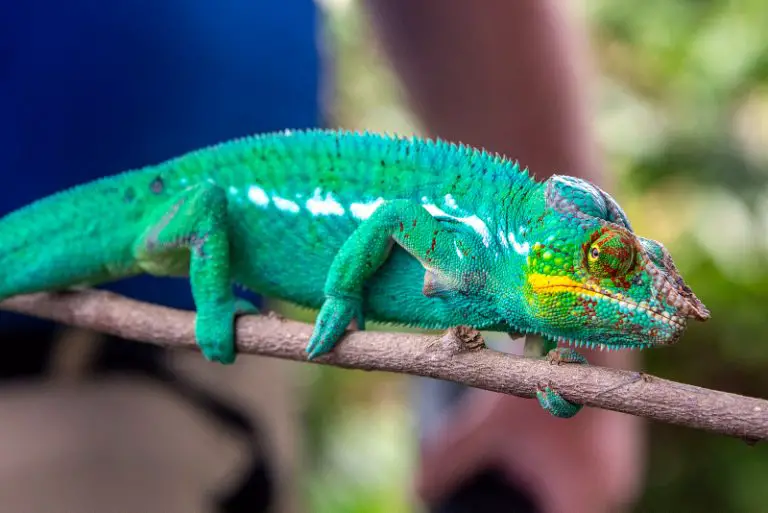
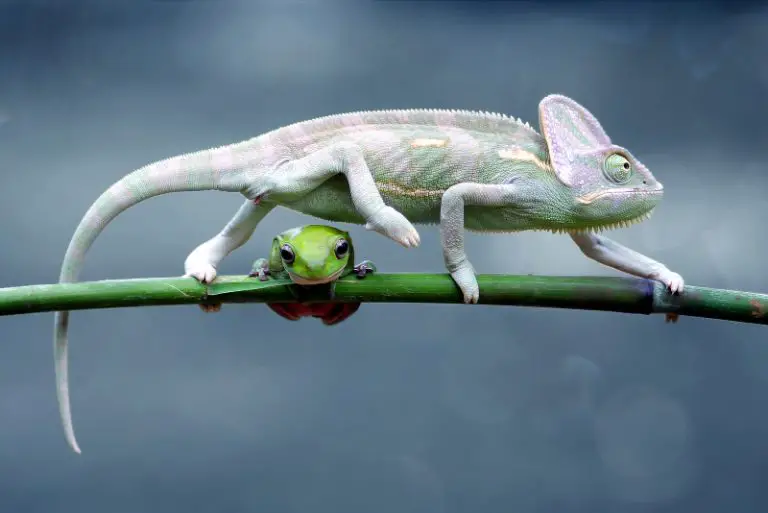
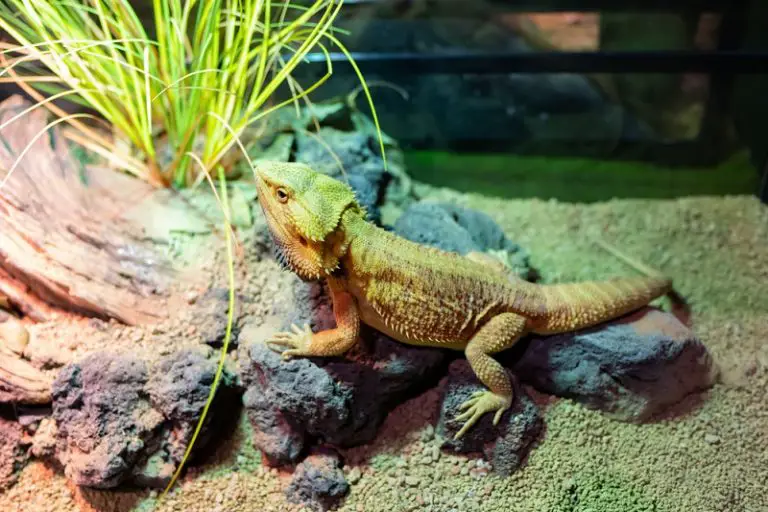
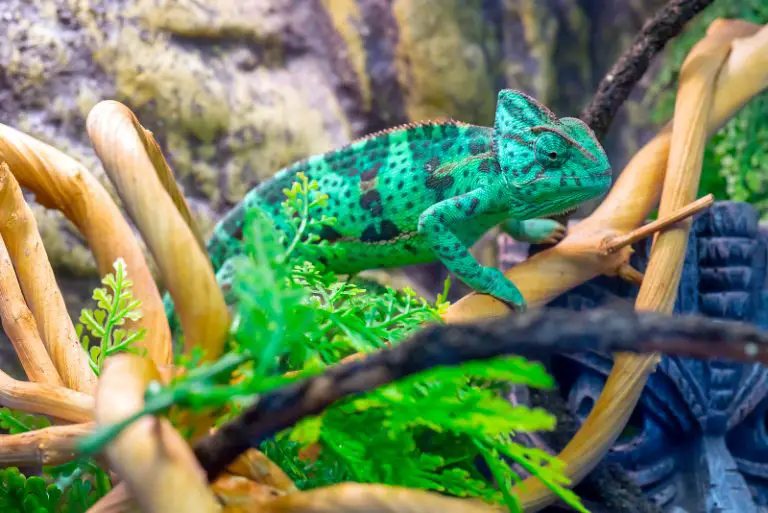
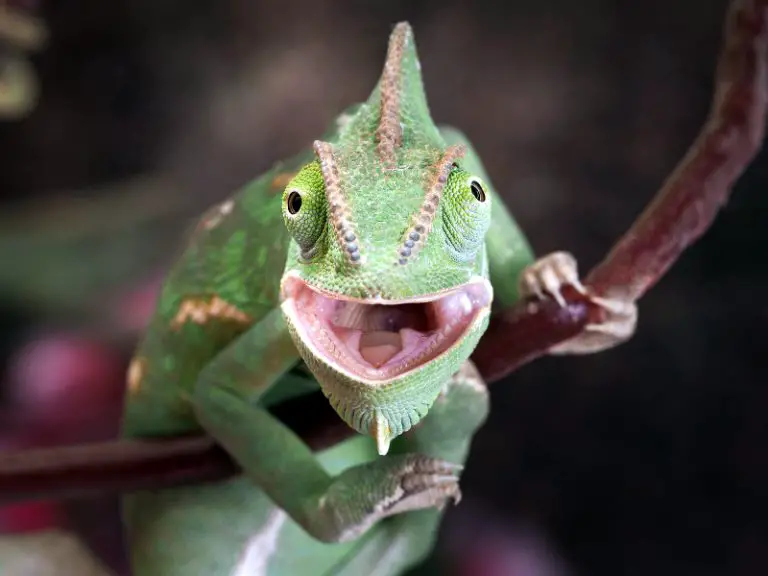
![How Often Do Veiled Chameleons Eat? [Full Eating Guide]](https://allourcreatures.com/wp-content/uploads/2021/12/veiled-chameleon-768x508.jpg)